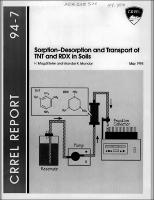Please use this identifier to cite or link to this item:
https://hdl.handle.net/11681/9381| Title: | Sorption-Desorption and transport of TNT and RDX in soils |
| Authors: | Department of Defense. RDT&E Strategic Environmental Research and Development Program (U.S.) Selim, Hussein Magd Eldin, 1944- Iskandar, I. K. (Iskandar Karam), 1938- |
| Keywords: | Convection dispersion Sorption-desorption Kinetic retention TNT Multireaction models Transport RDX Explosives Explosive ordinance Explosive ordinance disposal Soils |
| Publisher: | Cold Regions Research and Engineering Laboratory (U.S.) Engineer Research and Development Center (U.S.) |
| Series/Report no.: | CRREL report ; 94-7. |
| Description: | CRREL Report Abstract: Batch and miscible-displacement experiments were conducted to determine the extent of adsorption-desorption and transport of 2,4,6-trinitrotoluene (TNT) and 2,3,5-trinitro-1,3,5-triazine (RDX) in soils. A reference bentonite clay, contaminated (Kolin) soil from the Louisiana Army Ammunition Plant, and two uncontaminated soils were used. The TNT isotherm for bentonite clay was described equally well using linear, Freundlich, Langmuir and modified Langmuir models. TNT adsorption and desorption isotherms showed a lack of hysteric behavior, with TNT retention as a fully reversible mechanism. Transport results from bentonite clay columns indicated that TNT was a highly mobile contaminant and fully conservative in the presence of methanol as the background solution. Mobility of TNT was strongly retarded, with some 50% of the applied TNT retained in the bentonite clay column when 0.005-M Ca(NO3)2 was the background solution. Transport results in Norwood (fine silty) soil columns revealed that TNT was strongly retained in this low-organic-matter and low-clay-content soil. The use of a transport model with either Freundlich or linear retention and an irreversible mechanism predicted the TNT transport data well. Poor predictions were obtained when model parameters based on batch retention data were used. Reasons for model failure may be attributable to TNT sorption-kinetics and retention because of diffusion into clay lattices. Transport results indicated high mobility of RDX with limited retardation, which is consistent with release and transport data from the contaminated soil. |
| Rights: | Approved for public release; distribution is unlimited. |
| URI: | http://hdl.handle.net/11681/9381 |
| Appears in Collections: | CRREL Report |
Files in This Item:
| File | Description | Size | Format | |
|---|---|---|---|---|
| CR-94-7.pdf | 1.03 MB | Adobe PDF |  View/Open |